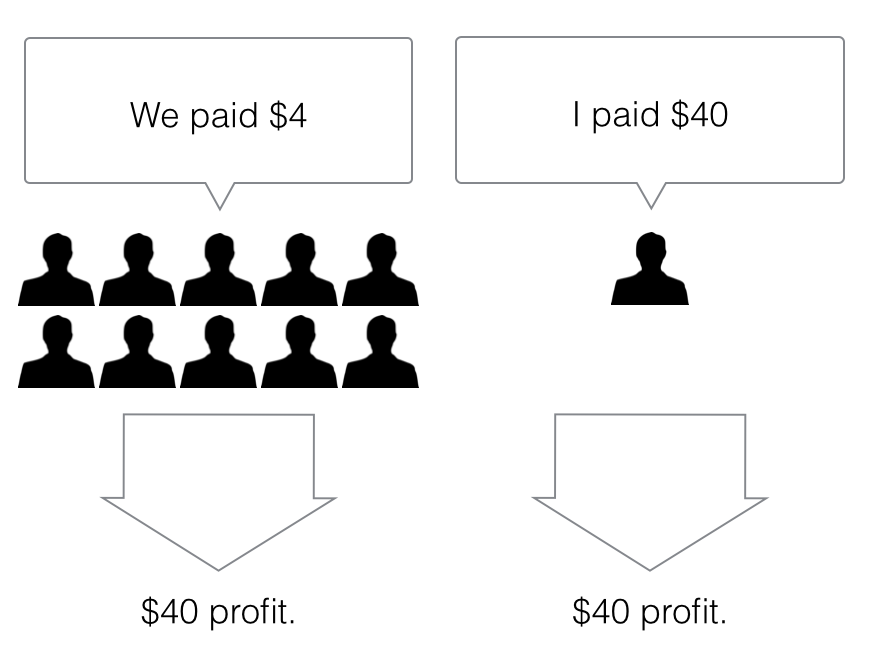Price Strategies to Use When You Have No Clue How to Price Your Product
You made your most important decision when you decided to sell digital products. Now you have another important decision. How to price your product? What price strategy to use?
Before you reach for an arbitrary number, pause and do some thinking. As you move toward the potential big-buck business of digital sales, you need to know what price will bring you the best profits. How do you decide?
I have some good news. Determining the right price for any digital product is not complicated.
Of course, you can make it as complicated as you want. You can do split A/B testing, market research, statistical analysis, customer persona development, target audience surveys, and comparative pricing. If you do that, you’ll likely come up with the perfect price range. Good for you.
But, as Chris Brogan explains:
“Pricing is always kind of random.”
Besides, all those complicated-sounding marketing moves that I mentioned in the paragraph above either require a lot of time or money. That’s time and money that you’re losing by delaying going to market with your product.
Thankfully, there is just a single pricing rule that will reduce the randomness, while giving you the assurance that the price is right. I’m going to explain this rule, and provide a few disclaimers at the end.
The golden rule for selling digital products: Price high.
Those who have made it big in the digital sales industry all say the same thing — make it expensive. You see, “expensive” is a relative term. If someone really wants your product, they will pay for it.
This works particularly well in the ebook industry. I once paid $25 for a 80-something page PDF on Evernote. Why? Because I’m an Evernote fanboy, and I wanted to know how to become an Evernote ninja. The price was worth it.
Chris Brogan who makes millions of dollars selling digital products, shares his secret:
“Be VERY wary of pricing your digital content really low.”
He sells an 100-page ebook for $97. People buy it.
Is that expensive? Yeah. But is it worth it? To the right people, yes.
The smartest sellers know that high prices win the day.
The mind trick of high prices.
There’s a psychology behind high prices. When something costs more, it is perceived to be of higher value. For example, people will pay more for a Breitling wristwatch than a Seiko. Why? Among other reasons, the value of a Breitling is reputably greater than a Seiko.
But isn’t there that component of name brand recognition? Absolutely, but most people possess that experiential response to high prices, that more expensive means better quality.
Even apart from a name brand, a higher price suggests higher value. Although you may not have the name “Chris Brogan,” or “Tim Ferriss” attached to your digital product, you nonetheless have the power of a price to sway your customer’s minds. The higher the cost, the more perceived value your product carries.
Tricking yourself with low prices.
This mind trick goes both ways. When you establish a low price point for your product you are devaluing your own product in your own mind in a subconscious way. When you tack on a paltry price tag, you’re probably not thinking to yourself, “This is a high value product. It’s worth a lot of money.”
Instead, you’re betraying your own innate cheapskate tendencies. There’s nothing wrong with being a budget-conscious spendthrift.
But there is a problem with devaluing yourself and your products. There is a problem with having little respect for yourself and your product. This kind of mentality destroys your passion and drive for your product. It erodes your confidence. It drains your optimism.
And it reduces your profit.
The myth of cheap.
I anticipate the objections. “But if my product is cheaper, won’t more people buy it? The answer is “probably yes.” Just because more people buy it, though, doesn’t mean that you’ll earn more profits. More customers do not translate into profits.
Keep these factors in mind regarding high-priced items:
The people who really want your product will pay any price, even a seemingly exorbitant price. Experienced digital sales professionals tell us that it’s painful to price products so high. But once they get over that inner resistance, they’re glad that they did it.
There are people out there who are craving what you’re selling. For these potential customers, price is not an issue. If you have what they need, they will find a way to buy it.
The people who are on the fence about your product may or may not buy it. Some will, and some won’t. The on-the-fencers will probably divide evenly with 50% buying, and 50% not buying. However, the loss of those on-the-fence customers will be negligible compared to the profits you are making from the few who do buy.
Let’s look at an example. If your product costs $4, and you have ten customers then you’ve earned $40. However, if your product costs $40, and only one person buys, you’ve made the same amount of profit from a single customer.

The people who buy your product will value it more due to its high price. Not only do we perceive higher-priced items to be valuable, but we also behave accordingly once we have that product in our possession. A $2.99 digital download may or may not be something that I blog about, Tweet about, or endorse.
However, if I spent $30 on that product, I instinctually treasure it more. This transforms me into an evangelist for the product. Higher priced products translate into higher-value customers. These customers in turn may become endorsers, advocates, and advertisers for your product.
Testing and experience shows that higher prices produce higher profits.
Having read and listened to industry thinkers such as Ramit Sethi, Tim Ferriss, Noah Kagan, and Chris Guillebeau, I’ve been persuaded that higher prices work. I’ve become swayed not just by their coolness, but by the data, too.
In an article from Marketing Profs, Nick Usborne describes a test.
“The highest price was the ‘torture’ price, to see how high the price could be pushed. As it turned out, it was the highest price that generated the most revenue, by a significant margin.”
In a conversation between Patrick McKenzie and Ramit Sethi, these two experienced digital sales mavens hammered home this point:
“Price for dear or price for free but never price for cheap.”
That advice is worth millions.
Lower prices cost you.
Mike Geary makes a million bucks a month selling a digital product. He’s done plenty of testing, and found this to be true:
“Lower price points can sometimes bring in more customers on the front end, but the backend marketing plan needs to be solid in order to make up for the lower price.”
Most startup digital entrepreneurs don’t have a “backend marketing plan,” much less a marketing department. Thus, the most sensible move is not to price low but high. Remember, your goal isn’t more customers. Your goal is more profit.
When you price a product at a dirt-cheap rate, you’re going to have to pay for your discount. You’ll buy more ads to sell more products. You’ll buy more mailing lists to sell to more people. You’ll buy more marketing savvy. You devalue your brand, which costs severely. You minimize your chance at future growth, which can cripple a business from the start.
If you don’t price your product right, you’ll have to pay the difference. That kind of defeats the whole point of selling something.
Now, for the disclaimers.
Clearly, I advocate for higher priced products. However, I’d like to make it apparent that a fat price tag alone will not propel you to success. I have two disclaimers.
Sell something truly valuable. All of this advice for high prices is completely meaningless if you’re selling something worthless. If you’re selling something for a lot of money, you have an ethical obligation to offer something of real value.
If you offer a slipshod, half-baked piece of garbage, you might as well price it at $0.99 then go off to find a different career. In order to be successful, you have to create value, and then believe in that value enough to sell it at a premium.
Do testing. Despite my introductory dismissal of market research, I am a supporter of it. If you have time and resources. One of those guru market analysts is Paras Chopra, who has written a handy piece on A/B testing. He admits that it is difficult and time-consuming, but explains a way to do so that will help you maximize your profits.
Bottom line: price high. Higher prices mean higher profits. That makes you happy. Besides, as McKenzie and Sethi concluded, “Your customers would be happier if you charged more” too.





